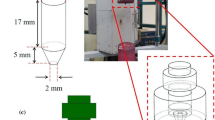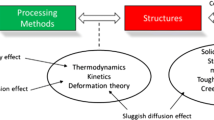Abstract
The problems of the consequence of heat treatment of alloys performed using the concept of an ordering–separation phase transition are considered. Fe50Cr50 and Ni88Al12 alloys and U13 steel are used as examples to show that this transition occurs at a temperature specific for each system, and a change in the sign of the chemical interaction between alloy component atoms changes the direction of diffusion fluxes in alloys into the opposite direction, which changes the type of microstructure. The detection of this phase transition radically changes the generally accepted concepts of heat treatment of alloys. This finding calls for transmission electron microscopy investigations to modify the phase diagrams where this phase transition was detected. It is concluded that quenching of alloys from a so-called solid-solution field, which is usually performed before tempering (aging), is an unnecessary and useless operation, since the final structure of an alloy forms upon tempering (aging) irrespective of the structure existing before this heat treatment.
Similar content being viewed by others
References
J. E. Woodilla and B. L. Averbach, “Modulated structures in Au–Ni alloys,” Acta Metall. 16, 255–263 (1968).
A. A. Chevalier and W. M. Stobbs, “An electron diffraction study of short-range order in quenched Ni4Mo alloy,” Acta Metall. 24, 535–542 (1976).
J. Higgins, R. B. Nicholson, and P. Wilkes, “Precipitation in the iron–beryllium system,” Acta Metall. 22, 201–217 (1974).
D. E. Laughlin and J. W. Cahn, “Spinodal decomposition in age-hardening Cu–Ti alloys,” Acta Metall. 23, 329–343 (1975).
V. A. Phillips and L. E. Tanner, “High-resolution electron microscope observations on GP zones in an aged Cu–2 wt % Be crystal,” Acta Metall. 21, 441–448 (1973).
P. E. Flewitt, “Phase transformations in Nb 16 to 40% Zr alloys above the monotectoid temperature,” Acta Metall. 22, 47–63 (1974).
A. Guinier, X-ray Diffraction in Crystals, Imperfect Crystals, and Amorphous Bodies (Freeman, San Francisco, 1963).
Y. Ustinovshikov and V. Pushkarev, “Ordering, phase separation, and phase transitions in Fe–M alloys,” Usp. Fiz. Nauk 176, 611–621 (2006).
Y. Ustinovshikov, “Chemical phase transition in alloys: ordering phase separation,” COSSMS (Current Opinion of Solid State and Materials Science) 14, 7–20 (2010).
Y. Ustinovshikov, “Evolution of the microstructure of Ni75V25 and Ni75V20A15 alloys at changing the temperature,” J. Alloys Compd. 575, 10–16 (2013).
V. I. Izotov and L. M. Utevsky, “Structure of martensite crystals of high-carbon steel,” Fiz. Met. Metalloved. 25, 98–110 (1968).
S. Nagakura, K. Shiraishi, and Y. Hirotsu, “Observation of carbon atom clusters in iron–carbon martensite,” Trans. JIM 16, 601–602 (1975).
S. Nagakura, K. Shiraishi, and M. Toyoshima, “Crystal structure and morphology of the ordered phase in iron–carbon martensite,” Trans. JIM 20, 100–110 (1979).
M. Kusunoki and S. Nagakura, “Modulated structure of iron–carbon martensite studied by electron microscopy and diffraction,” J. Appl. Crystallogr. 10, 329–336 (1981).
Y. D. Tyapkin, I. Y. Georgieva, V. A. Golikov, and A. A. Gulyaev, “Modulated structure of high-carbon martensite,” Physics-Doklady 221, 335–338 (1975).
B. P. J. Sandvik and C. M. Wayman, “Direct observation of carbon clusters in a high-carbon martensitic steel,” Metallography 16, 429–447 (1983).
C. Wells, “Graphitization in high-purity iron-carbon alloys,” Trans. Amer. Soc. Met. 26, 289–307 (1938).
Y. Ustinovshikov and I. Shabanova, “Phase transitions in alloys of the Ni–Mo system,” Mater. Chem. Phys. 129, 975–980 (2011).
Y. Ustinovshikov, “Phase transition “ordering–phase separation” in the Ni–12 at % Al alloy,” J. Alloys Compd. 528, 141–145 (2012).
Y. Ustinovshikov, I. Shabanova, and N. Lomova, “TEM study of the “ordering–phase separation” transition in Ni–Co alloys,” J. Advanc. Microscopy Res. 8, 27–32 (2013).
Author information
Authors and Affiliations
Corresponding author
Additional information
Original Russian Text © Yu.I. Ustinovshchikov, 2015, published in Metally, 2015, No. 5, pp. 81–90.
This article was approved by the editorial board for discussion.
Rights and permissions
About this article
Cite this article
Ustinovshchikov, Y.I. Phase transition ordering–separation: A new approach to heat treatment of alloys. Russ. Metall. 2015, 745–752 (2015). https://doi.org/10.1134/S003602951509013X
Received:
Published:
Issue Date:
DOI: https://doi.org/10.1134/S003602951509013X




